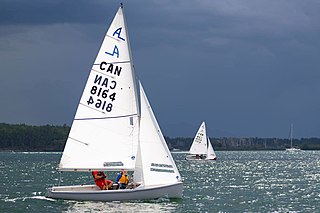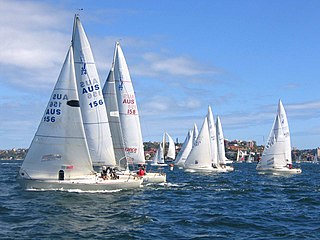
Dinghy sailing is the activity of sailing small boats by using five essential controls:

Dinghy racing is a competitive sport using dinghies, which are small boats which may be rowboats, have an outboard motor, or be sailing dinghies. Dinghy racing has affected aspects of the modern sailing dinghy, including hull design, sail materials and sailplan, and techniques such as planing and trapezing.

The Albacore is a 4.57 m (15 ft) two-person planing dinghy, for competitive racing and lake and near-inshore day sailing. Hulls are made of either wood or fiberglass. The basic shape was developed in 1954 from an Uffa Fox design, the Swordfish. Recent boats retain the same classic dimensions, and use modern materials and modern control systems.

The Laser is a class of single-handed, one-design sailing dinghies using a common hull design with three interchangeable rigs of different sail areas, appropriate to a given combination of wind strength and crew weight. Bruce Kirby designed the Laser in 1970 with an emphasis on simplicity and performance.

World Sailing (WS) is the world governing body for the sport of sailing recognized by the International Olympic Committee and the International Paralympic Committee (IPC).

The 18 ft Skiff is considered the fastest class of sailing skiffs. The class has a long history beginning with races on Sydney Harbour, Australia in 1892 and later in New Zealand. The boat has changed significantly since the early days, bringing in new technology as it became available. Because of the need of strength, agility and skill, the class is considered to be the top level of small boat sailing. Worldwide this boat is called the "18 Foot Skiff". It is the fastest conventional non-foiling monohull on the yardstick rating, with a score of 675, coming only third after the Tornado and Inter 20.
The Inter-Collegiate Sailing Association (ICSA) is a volunteer organization that serves as the governing authority for all sailing competition at colleges and universities throughout the United States and in some parts of Canada.

The International 14 is a British one-design racing sailboat, crewed by two sailors. The class was established in 1928.

The 12 ft Skiff is a development dinghy class dating back to the early 20th century. It is sailed in Australia and New Zealand. It is 12 ft (3.7 m) in length, hence the name, and is a two-man boat. Both the crew and the helm are able to use the trapeze at the same time. It has an asymmetrical spinnaker and a jib, in addition to the mainsail.

The Nepean Sailing Club (NSC) is a sailing club located on Lac Deschênes in Ottawa, Ontario, Canada. The club is based in Dick Bell Park, along Carling Avenue, adjacent to Andrew Haydon Park in the former city of Nepean.
The Corsair is a class of sixteen foot, three handed sailing dinghy. The boat was designed by Australian designer Alan Payne who is famous for designing Sir Frank Packer's America's Cup challenge yachts Gretel and Gretel II.
Iain Murray AM is an Australian sailor and yacht designer
The 29erXX is a high performance sailing skiff, it was designed to allow light crews, particularly female crews, to sail twin trapeze boats and as a training boat for the more powerful 49er. The class gained International Sailing Federation Class status in May 2011, but lost it in 2014.

The Buzz is a sailing dinghy designed in 1994 by Ian Howlett and John Caig and manufactured by Reg White Limited of Brightlingsea as part of the "White Formula" range of boats originally marketed by Topper International Ltd but since 2013 by Vantage Sailing. The Buzz is a double handed racing boat, with a single trapeze for the crewman. The boat has a fully battened mainsail, furling jib and an asymmetrical spinnaker. There have been around 500 boats built. The Buzz is designed to be an easy to sail boat, but it can also be raced competitively.
The Naples Sabot is an 8-foot (2.4 m) sailing dinghy. The Naples Sabot was designed by Roy McCullough and R.A. Violette and the first two were built in Violette's garage during WW II, although official designs were not made available until 1946. The Naples Sabot is based on the Balboa Dinghy and on Charles MacGregor's Sabot as published in Rudder magazine, April 1939. It takes its name from Naples in Long Beach, California, where it was developed.

The sport of sailing involves a variety of competitive sailing formats that are sanctioned through various sailing federations and yacht clubs. Racing disciplines include matches within a fleet of sailing craft, between a pair thereof or among teams. Additionally, there are specialized competitions that include setting speed records. Racing formats include both closed courses and point-to-point contests; they may be in sheltered waters, coast-wise or on the open ocean. Most competitions are held within defined classes or ratings that either entail one type of sailing craft to ensure a contest primarily of skill or rating the sailing craft to create classifications or handicaps.

The Britannia Yacht Club (BYC) is a private social club, yacht club and tennis club based in Britannia, Ottawa, Ontario, Canada. It was founded in 1887 by a group of cottagers.
Graeme Hayward was a Canadian Fourteen Foot Dinghy Hall of Fame Inductee by the Canadian Dinghy Association at Royal Canadian Yacht Club Toronto 2011
Julian Bethwaite is an Australian, Sydney-based skiff sailor and sailboat designer. He wrote one chapter of his father Frank's book, Higher Performance Sailing.

Chester Yacht Club (CYC) is a private yacht club located in Chester, Nova Scotia, Canada, established in 1902. The Chester Yacht Club is home to Canada's largest keelboat regatta, Chester Race Week, which occurs every August. Notable members of the Chester Yacht Club include Olympians Jacob Saunders and Graeme Saunders, who started sailing with the club's junior sailing school in 2002, and philanthropist Sir Christopher Ondaatje, who owns a nearby island. The club also has an all-wood International One Design (IOD) fleet, which competes in the IOD World Championships.














